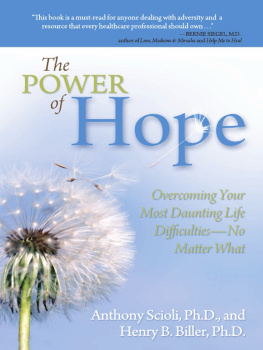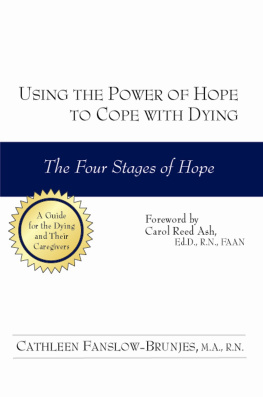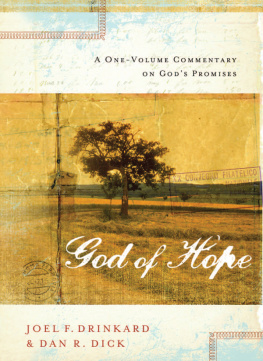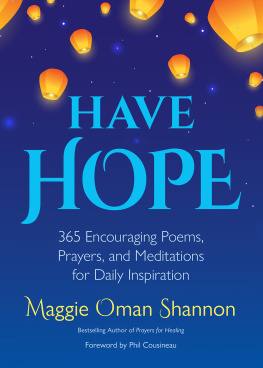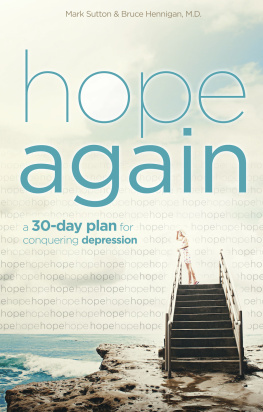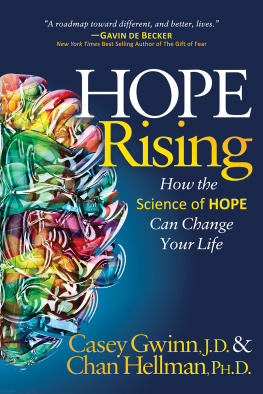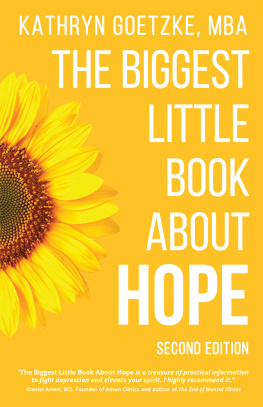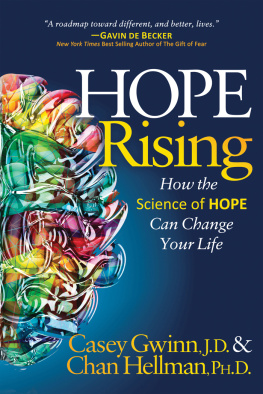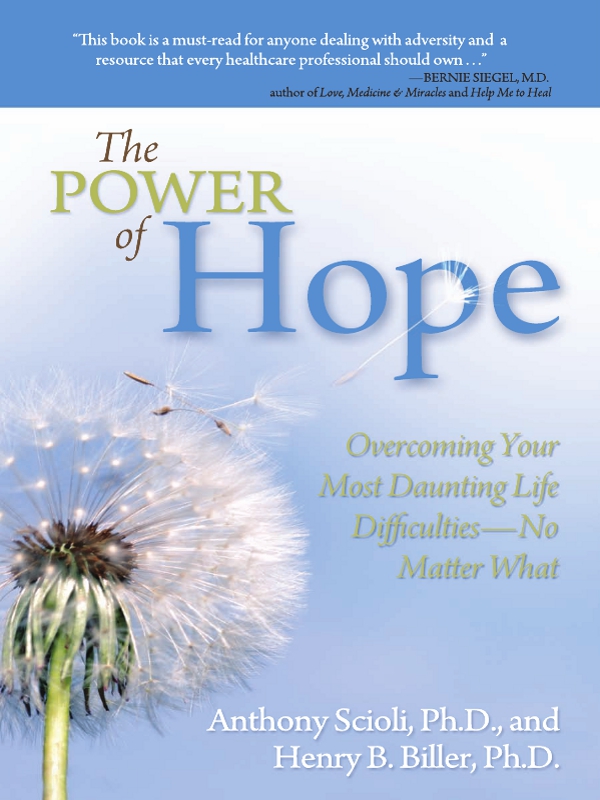
The
POWER
of HOPE
Overcoming Your Most Daunting Life
DifficultiesNo Matter What
ANTHONY SCIOLI, PH.D.
HENRY B. BILLER, PH.D.

www.hcibooks.com
Library of Congress Cataloging-in-Publication Data
Scioli, Anthony
The power of hope : overcoming your most daunting life difficultiesno matter what / by Tony Scioli and Henry B. Biller.
p. cm.
Includes bibliographical references.
eISBN-13: 978-0-7573-9344-0 (ebook) eISBN-10: 0-7573-9344-6 (ebook)
1. Positive psychology. 2. Hope. 3. Optimism. I. Biller, Henry B. II. Title.
BF204.6.S254 2010
158dc22
2010002240
2010 Anthony Scioli and Henry B. Biller
All rights reserved. Printed in the United States of America. No part of this publication may be reproduced, stored in a retrieval system, or transmitted in any form or by any means, electronic, mechanical, photocopying, recording, or otherwise, without the written permission of the publisher.
HCI, its logos, and marks are trademarks of Health Communications, Inc.
Publisher: Health Communications, Inc.
3201 S.W. 15th Street
Deerfield Beach, FL 334428190
Cover design by Larissa Hise Henoch
Inside design by Lawna Patterson Oldfield
Formatted by Dawn Von Strolley Grove
TO ERICA,
THE GREAT HOPE PROVIDER
IN MY LIFE.
Tony Scioli
TO SUZETTE RIVER,
THE LIGHT AND LOVE OF MY LIFE
AND HER TALENTED DAUGHTER SOLEIL.
Henry B. Biller
CONTENTS
Acknowledgments
CHAPTER 4: Whats in Your Hope Chest?
CHAPTER 7: Hope, Not Fear
CHAPTER 10: Hope for Health
L ike hope itself, the birth and growth of this book has been a collaborative process, involving higher aims as well as trust, openness, and patience.
Beyond our personal collaboration, our students have been a big help, scoring questionnaires and entering data for the research reported in this book as well as doing library searches for the reference section. Phil Scioli assisted in the development of the first versions of the hope test that you will find at the beginning and end of this book.
We would like to thank our editor, Michele Matrisciani at Health Communications, Inc., for her enthusiastic support of this book, her dedication and wise counsel in crafting an accessible manuscript, and her unending supply of wit and humor. Judith Antonelli did a brilliant job of copyediting and fact checking. Carol Susan Roth, our literary agent, supported our vision from the start, and generously shared her time and experience with us.
Finally, we would like to thank our families and friends for their many years of love, support, and understanding.
PART ONE:
UNDERSTANDING
HOPE
We designed Part One of this book to provide you with a deeper understanding of hope. In Chapter 1 we explain why hope may be our most important emotion, as fundamental to human life as the air that we breathe or the water that we drink. In Chapter 2 we introduce definitions of hope offered by psychologists, philosophers, and other experts, culminating in our own integrative understanding of this complex emotion. In Chapter 3 we explore the dangers of losing hope, and describe the nine types of hopelessness that can plague an individual. Chapter 4 deals with cultural and spiritual factors that influence the development of hope. We review the hopes of different cultures and religions, while also addressing forms of spirituality that are not necessarily religious in nature. We highlight the centrality of faith in the development of hope and include a spiritual assessment tool that can give you a greater insight into your particular spiritual needs.
Why Hope?
W e live in a world that is in desperate need of hope. You cannot turn on the television, click on the radio, or browse the Internet without being inundated with more doom and gloom about the economy, renewed hostilities in the Middle East, violence at home and abroad, another scandal involving a religious leader or a politician, or further warnings about food safety, fuel supplies, or global warming. In short, there seems to be increasingly little chance of securing the feelings of community, prosperity, and peace that make life worth living. In the past, one could find comfort and trust in a cloistered village or a well-established neighborhood, empowerment through the monarchy or government, and security in the fold of an ever-present savior. For those living in oppression or poverty, there was always the possibility of traveling to greener pastures. In contrast, today it seems that there are few, if any, safe harbors.
In this darkest of times, a true sense of belonging is hard to find, governments and other institutions appear increasingly impotent, and faith in a higher power has seriously eroded. Even in the most industrialized nations, many people have achieved great affluence without deriving any clear sense of purpose in life. Instant messages are sent around the globe, yet so many remain lonely and isolated. Occasional medical and political advances provide brief glimmers of hope. However, these scattered signs of light are dwarfed by ominous reports of resistant and deadly microbes and increasingly brazen acts of global terrorism. In short, the signs of hopelessness are everywhere.
Hope is about mastery, a feeling of empowerment, and a sense of purpose that is collaborative and focused on higher goals. In stark contrast, millions of adults are now losing their jobs. High school graduates and their parents are finding it increasingly difficult to pay for a college education. Others possess skills that are undervalued and undercompensated. Even for those who manage to remain in the workforce, many feel trapped in despised jobs or careers they cannot leave, worried that they may suffer an even worse fate.
Hope is about attachment, a belief in the continued presence of a loved one, a mentor, or an ally who fosters a sense of connection, trust, and openness. Clearly, such bonds of hope were not available to Eric Harris or Dylan Klebold, the Columbine killers, or Seung-Hui Cho, the Virginia Tech shooter. For countless other brooding youth who are simmering with hopeless rage, hope providers are badly needed. Many teens and young adults who are devoid of healthy role models will often join a gang as a way of securing a sense of belonging and mastery, however distorted and dangerous. The same crisis of connection defines the life of a forsaken individual with HIV or AIDS who is living on the streets or is relegated to a dark and lonely hospital bed.
Hope is about survival, a belief that you will be liberated from harm, that options will always be available to you, and that you can rest assured that everything will be fine. This dimension of hope is particularly elusive for the trauma survivor. Perhaps you are a war veteran, a victim of a violent crime, or an adult who was seriously hurt as a child. You might feel traumatized and trapped by an abusive or a controlling partner. Maybe you are facing retirement or can no longer live completely on your own.
Hope is often spiritual, not necessarily in the religious sense, but in terms of having faith, a sense of meaning in life, a connection to something greater, or a belief in a benign universe. In this period of great unrest, it is understandable if you or a loved one is suffering from a crisis of faith. If you have a religious inclination but find yourself stricken with a serious illness, a divorce, or being fired or laid off, you may be wondering where is God? If you are not religious but consider yourself spiritual, yet are now facing the foreclosure of your home, lack of funds to send your child to college, betrayal by your spouse, a close friend, or a business associate, your belief in a well-ordered cosmos may be shattered.
Next page
